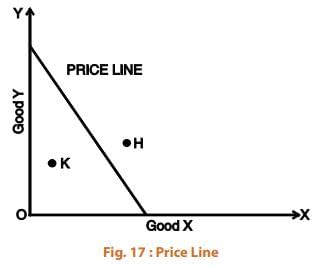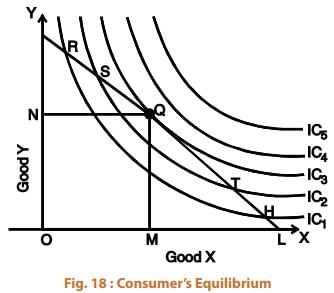The Budget Line
A higher indifference curve shows a higher level of satisfaction than a lower one. Therefore, a consumer, in his attempt to maximise satisfaction will try to reach the highest possible indifference curve. But in his pursuit of buying more and more goods and thus obtaining more and more satisfaction, he has to work under two constraints: first, he has to pay the prices for the goods and, second, he has a limited money income with which to purchase the goods.
A consumer’s choices are limited by the budget available to him. As we know, his total expenditure for goods and services can fall short of the budget constraint but may not exceed it.
Algebraically, we can write the budget constraint for two goods X and Y as:
PxQx+PyQy ≤ B
Where
PX and PY are the prices of goods X and Y and QX and QY are the quantities of goods X and Y chosen and B is the total money available to the consumer.
The budget constraint can be explained by the budget line or price line. In simple words, a budget line shows all those combinations of two goods which the consumer can buy spending his given money income on the two goods at their given prices. All those combinations which are within the reach of the consumer (assuming that he spends all his money income) will lie on the budget line.

It should be noted that any point outside the given price line, say H, will be beyond the reach of the consumer and any combination lying within the line, say K, shows under spending by the consumer.
This slope of budget line is equal to ‘Price Ratio’ of two goods. i.e. PX /PY
Consumer’s Equilibrium
Having explained indifference curves and budget line, we are in a position to explain how a consumer reaches equilibrium position. A consumer is in equilibrium when he is deriving maximum possible satisfaction from the goods and therefore is in no position to rearrange his purchases of goods. We assume that:
(i) The consumer has a given indifference map which shows his scale of preferences for various combinations of two goods X and Y.
(ii) He has a fixed money income which he has to spend wholly on goods X and Y.
(iii) Prices of goods X and Y are given and are fixed.
(iv) All goods are homogeneous and divisible, and
(v) The consumer acts ‘rationally’ and maximizes his satisfaction

To show which combination of two goods X and Y the consumer will buy to be in equilibrium we bring his indifference map and budget line together.
We know by now, that the indifference map depicts the consumer’s preference scale between various combinations of two goods and the budget line shows various combinations which he can afford to buy with his given money income and prices of the two goods. Consider Figure 18, in which IC1 , IC2, IC3, IC4 and IC5 are shown together with budget line PL for good X and good Y. Every combination on the budget line PL costs the same. Thus combinations R, S, Q, T and H cost the same to the consumer. The consumer’s aim is to maximise his satisfaction and for this, he will try to reach the highest indifference curve.
Since there is a budget constraint, he will be forced to remain on the given budget line, that is he will have to choose combinations from among only those which lie on the given price line.
Which combination will our hypothetical consumer choose? Suppose he chooses R. We see that R lies on a lower indifference curve IC1 , when he can very well afford S, Q or T lying on higher indifference curves. Similar is the case for other combinations on IC1 , like H. Again, suppose he chooses combination S (or T) lying on IC2 . But here again we see that the consumer can still reach a higher level of satisfaction remaining within his budget constraints i.e., he can afford to have combination Q lying on IC3 because it lies on his budget line. Now, what if he chooses combination Q? We find that this is the best choice because this combination lies not only on his budget line but also puts him on the highest possible indifference curve i.e., IC3 . The consumer can very well wish to reach IC4 or IC5 , but these indifference curves are beyond his reach given his money income. Thus, the consumer will be at equilibrium at point Q on IC3 . What do we notice at point Q? We notice that at this point, his budget line PL is tangent to the indifference curve IC3 . In this equilibrium position (at Q), the consumer will buy OM of X and ON of Y.
We have seen that the consumer attains equilibrium at the point where the budget line is tangent to the indifference curve and
MUx / Px = MUy /Py
At the tangency point Q, the slopes of the price line PL and the indifference curve IC3 are equal. The slope of the indifference curve shows the marginal rate of substitution of X for Y (MRSxy) which is equal to  while the slope of the price line indicates the ratio between the prices of two goods i.e
while the slope of the price line indicates the ratio between the prices of two goods i.e 
At equilibrium point Q,

Thus, we can say that the consumer is in equilibrium position when the price line is tangent to the indifference curve or when the marginal rate of substitution of goods X and Y is equal to the ratio between the prices of the two goods. The indifference curve analysis is superior to utility analysis:
(i) it dispenses with the assumption of measurability of utility
(ii) it studies more than one commodity at a time
(iii) it does not assume constancy of marginal utility of money
(iv) it segregates income effect from substitution effect.
SUMMARY- The existence of human wants is the basis for all economic activities in the society. All desires, tastes and motives of human beings are called wants in Economics.
- In Economics, wants are classified in to necessaries, comforts and luxuries.
- Utility refers to the want satisfying power of goods and services. It is not absolute but relative. It is a subjective concept and it depends upon the mental attitude of people.
- There are two important theories of utility, the cardinal utility analysis and ordinal utility analysis.
- The law of diminishing marginal utility states that as a consumer increases the consumption of a commodity, every successive unit of the commodity gives lesser and lesser satisfaction to the consumer.
Consumer surplus is the difference between what a consumer is willing to pay for a commodity and what he actually pays for it. - The indifference curve theory, which is an ordinal theory, shows the household’s preference between alternative bundles of goods by means of indifference curves.
- Marginal rate of substitution is the rate at which the consumer is prepared to exchange goods X and Y.
- The important properties of an Indifference curve are: Indifference curve slopes downwards to the right, it is always convex to the origin, two ICs never intersect each other, it will never touch the axes and higher the indifference curve higher is the level of satisfaction.
- Budget line or price line shows all those combinations of two goods which the consumer can buy spending his given money income on the two goods at their given prices.
- A consumer is said to be in equilibrium when he is deriving maximum possible satisfaction from the goods and is in no position to rearrange his purchase of goods.
- The consumer attains equilibrium at the point where the budget line is tangent to the indifference curve and
MUx / Px =MUy /Py = MUz /Pz
|


 while the slope of the price line indicates the ratio between the prices of two goods i.e
while the slope of the price line indicates the ratio between the prices of two goods i.e 




















